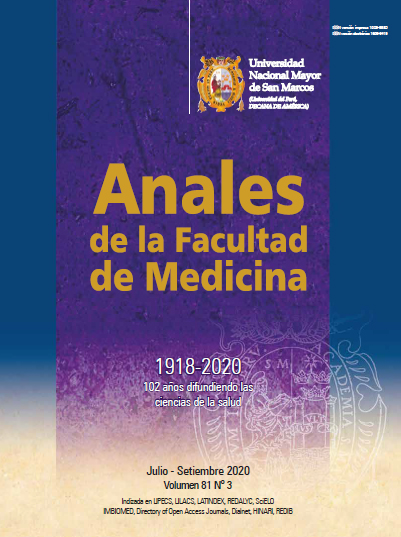Standardization and utility of counterimmunoelectrophoresis for the diagnosis of bartonellosis
DOI:
https://doi.org/10.15381/anales.v81i3.18713Keywords:
Counterimmunoelectrophoresis, Bartonella infections, Serology, Immunologic Tests, Antigens, SonicationAbstract
Introduction. Carrion’s disease, caused by the bacterium Bartonella bacilliformis, is a reemerging disease in Perú, which is conventionally diagnosed by blood smear and culture, which are not very sensitive methods, requiring alternative diagnostic methods. Objectives. To determine the sensitivity and specificity of the counterimmunoelectrophoresis (CIEP) using a sonicated antigen obtained from a Bartonella sp. strain, to detect antibodies against the bacteria compared to the culture as reference standard. Methods. The test antigen was obtained by sonication of an isolate of Bartonella sp., grown in a biphasic medium with and without sheep blood. The reactivity of the sonic antigen was evaluated by the CIEP using 123 sera from people, of which 60 were from patients with a clinical and bacteriological diagnosis of Carrión’s disease, 54 from people with other infections and 9 from healthy people. For the standardization of the CIEP test, the size and distance between the wells were evaluated, as well as the concentration of the antigen and the volumes of the reagents used. Results. The optimal concentration of the antigen was 0,64 mg/mL, the distance between the 3 mm wells, the size of the 3 mm wells and the volume of the reagents of 12 μL. The standardized CIEP had a sensitivity of 43,3% and a specificity of 98,4%. Conclusions. The results of the CIEP reveal a low sensitivity of the test, being able to be used as a confirmatory test given its high specificity but cannot be used as a serological screening test due to the low sensitivity referred to.
Downloads
Published
Issue
Section
License
Copyright (c) 2020 Anales de la Facultad de Medicina

This work is licensed under a Creative Commons Attribution-NonCommercial-ShareAlike 4.0 International License.
Those authors who have publications with this magazine accept the following terms:
- Authors will retain their copyrights and guarantee the journal the right of first publication of their work, which will be simultaneously subject to Creative Commons Attribution License that allows third parties to share the work as long as its author and its first publication this magazine are indicated.
- Authors may adopt other non-exclusive licensing agreements for the distribution of the version of the published work (eg, deposit it in an institutional electronic file or publish it in a monographic volume) provided that the initial publication in this magazine is indicated.
- Authors are allowed and recommended to disseminate their work over the Internet (eg: in institutional telematic archives or on their website) before and during the submission process, which It can produce interesting exchanges and increase quotes from the published work. (See El efecto del acceso abierto ).



